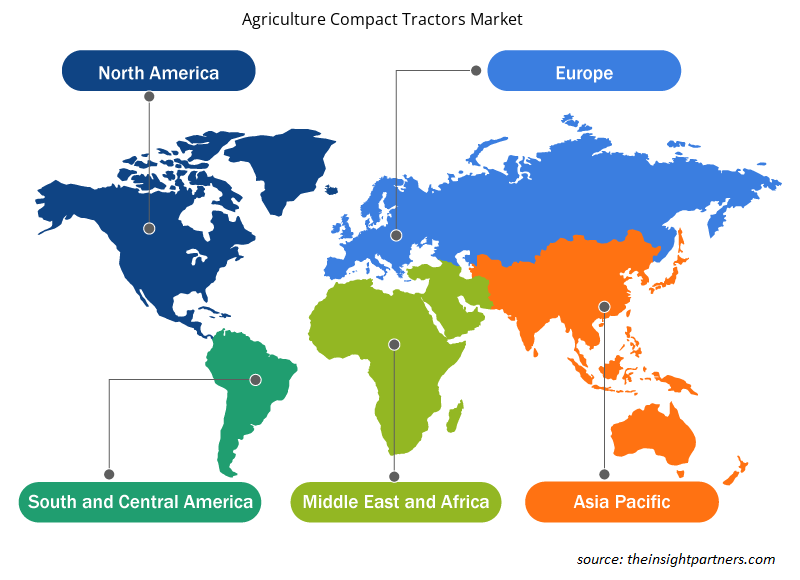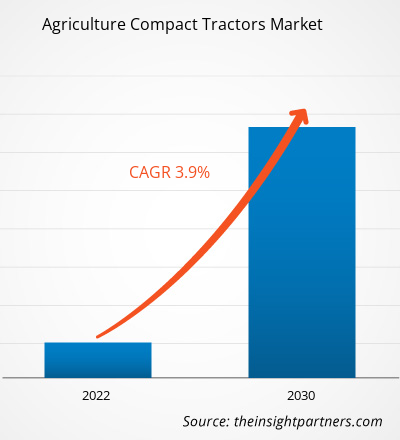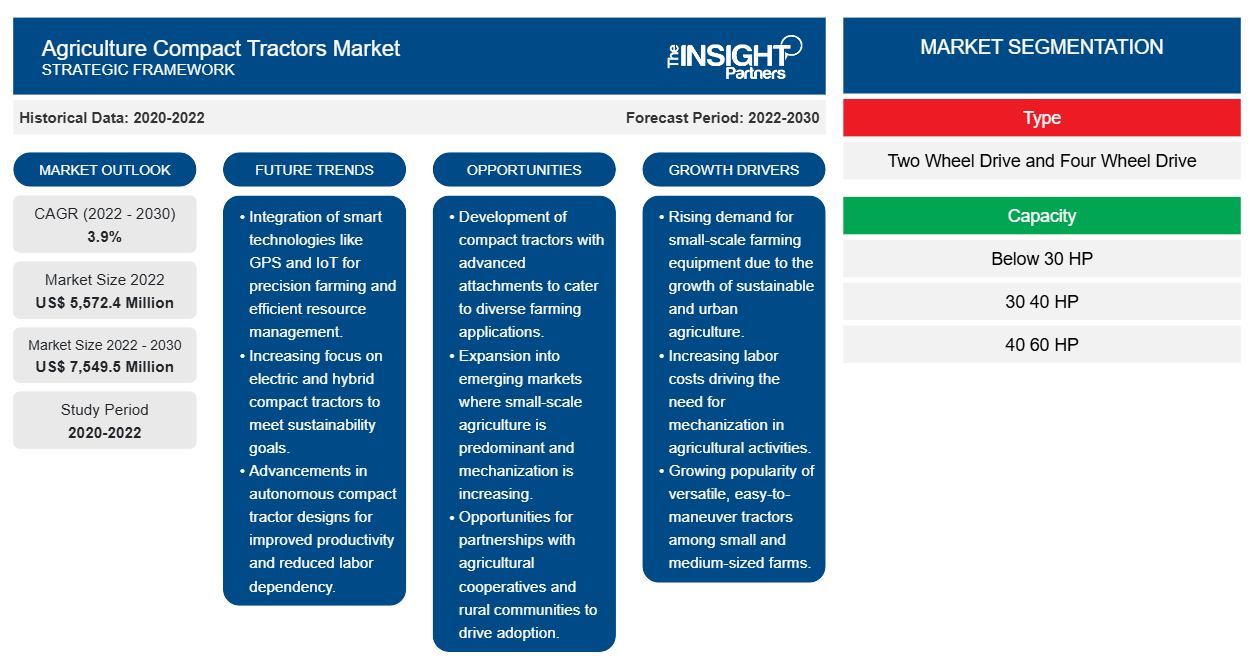[Informe de investigación] Se estima que el tamaño del mercado de tractores compactos agrícolas crecerá de US$ 5.572,4 millones en 2022 a US$ 7.549,5 millones en 2030; se espera que el mercado registre una CAGR del 3,9% de 2022 a 2030.
Perspectiva del analista:
El sector agrícola en continuo crecimiento, junto con una preferencia cada vez mayor por los equipos modernos, impulsa el crecimiento del mercado mundial de tractores agrícolas compactos . La demanda de alimentos está aumentando con una población en continuo crecimiento. Según las últimas previsiones ofrecidas por las Naciones Unidas, se prevé que la población mundial alcance los 8.500 millones en 2030 y se expanda aún más hasta los 9.700 millones en 2050. Como resultado, la demanda de productos agrícolas está aumentando rápidamente, lo que obliga a los agricultores a mejorar los rendimientos de sus explotaciones. Por tanto, la creciente escala de las actividades agrícolas impulsa la demanda de tractores agrícolas compactos.
En enero de 2024, LS Mtron Co., un fabricante surcoreano de maquinaria pesada y componentes electrónicos, presentó la nueva serie de tractores pequeños MT2·MT2E en América del Norte. Los dos modelos de esta serie, el MT2 premium y el MT2E económico, están diseñados para mejorar la comodidad operativa en lugares restringidos y son adecuados para la agricultura a pequeña escala. Esta línea de productos fue diseñada para varios trabajos, incluido un transbordador fácil de usar para operaciones suaves hacia adelante y hacia atrás, y pedales dobles adecuados para transferir tierra o grava. Estas actividades de desarrollo de productos por parte de los fabricantes de tractores agrícolas compactos impulsan el crecimiento del mercado de tractores agrícolas compactos.
Descripción general del mercado:
Los tractores compactos, conocidos habitualmente como tractores utilitarios compactos, se utilizan principalmente para pequeñas actividades agrícolas, como arar, segar, plantar, labrar y transportar. Son más pequeños en tamaño y capacidad, y más beneficiosos para granjas de pequeña escala, huertos frutales y de frutos secos, viñedos, jardines y céspedes. Los tractores compactos consumen menos combustible y requieren poco mantenimiento, lo que se traduce en bajos costos operativos.
La región de Asia Pacífico domina el mercado de tractores agrícolas compactos debido a la gran escala de las actividades agrícolas en países como China e India. Sin embargo, se espera que América del Norte y Europa registren fuertes valores de CAGR durante el período de pronóstico. Estados Unidos es uno de los principales productores de frutos secos y frutas. Según los datos publicados por el Departamento de Agricultura de Estados Unidos en 2022, las pequeñas explotaciones familiares representaban el 88% del total de explotaciones agrícolas en Estados Unidos. Por tanto, la presencia de una gran cantidad de pequeñas explotaciones en Estados Unidos es un factor clave que beneficia al mercado de tractores agrícolas compactos en este país.
Personalice este informe según sus necesidades
Obtendrá personalización en cualquier informe, sin cargo, incluidas partes de este informe o análisis a nivel de país, paquete de datos de Excel, así como también grandes ofertas y descuentos para empresas emergentes y universidades.
-
Obtenga las principales tendencias clave del mercado de este informe.Esta muestra GRATUITA incluirá análisis de datos, desde tendencias del mercado hasta estimaciones y pronósticos.
Conductor del mercado:
Iniciativas gubernamentales para apoyar a los pequeños agricultores
Las políticas gubernamentales y las iniciativas de apoyo, como la financiación, impulsan el número de granjas de pequeña escala en diferentes países. Por ejemplo, el Departamento de Agricultura de los Estados Unidos ofrece un Programa de Microcréditos a los agricultores de pequeña escala y principiantes que les permite obtener hasta 35.000 dólares en préstamos mediante solicitudes sencillas. Además, en 2023, el gobierno de Guyana anunció una iniciativa a través de su programa National Pathway for Food Systems. Como parte de este proyecto, se proporcionaron suministros de insumos agrícolas y una subvención única en efectivo a los pequeños agricultores y a los participantes en programas de empoderamiento socioeconómico continuos en todo el país. Estas iniciativas gubernamentales están empoderando a los pequeños agricultores para que adopten equipos agrícolas, incluidos tractores compactos. Además, estos programas e iniciativas crean un entorno propicio para las granjas agrícolas de pequeña escala en los países en desarrollo y desarrollados, lo que en última instancia da como resultado la expansión del tamaño del mercado de tractores compactos para la agricultura.
Análisis segmental:
El análisis del mercado de tractores agrícolas compactos se ha llevado a cabo teniendo en cuenta los siguientes segmentos: tipo, capacidad y aplicación. Sobre la base de la capacidad, el mercado se segmenta en menos de 30 HP, 30 HP-40 HP y 40 HP-60 HP. Los segmentos de 40 HP-60 HP y 30 HP-40 HP representan colectivamente más del 50% de la cuota de mercado de tractores agrícolas compactos. Estos tractores son adecuados para granjas de tamaño mediano para tareas como arar, labrar, plantar y cosechar. Por ejemplo, Farmtrac lanzó su nuevo tractor Farmtrac 60 Powermaxx en 2024. Este tractor tiene un motor de 55 HP y ofrece varias características.
Análisis regional:
El alcance geográfico del informe del mercado de tractores compactos agrícolas incluye América del Norte (EE. UU., Canadá y México), Europa (España, Reino Unido, Alemania, Francia, Italia y resto de Europa), Asia Pacífico (Corea del Sur, China, India, Japón, Australia y resto de Asia Pacífico), Medio Oriente y África (Sudáfrica, Arabia Saudita, Emiratos Árabes Unidos y resto de Medio Oriente y África) y América del Sur y Central (Brasil, Argentina y resto de América del Sur y Central). Asia Pacífico representó la mayor participación de mercado de tractores compactos agrícolas en 2022.
El mercado de tractores agrícolas compactos de América del Norte está segmentado en Estados Unidos, Canadá y México. El sector agrícola en América del Norte, en particular en países como Estados Unidos, Canadá y México, impulsa principalmente la demanda de tractores agrícolas compactos. La expansión del sector agrícola y los continuos desarrollos de productos seguirán impulsando el mercado en esta región en el futuro. Según los datos publicados por el Departamento de Agricultura de Estados Unidos en 2021, el sector agrícola contribuyó aproximadamente con 1,264 billones de dólares al PIB de Estados Unidos en 2021, lo que representa el 5,4% del PIB nacional. Según los datos publicados por el Gobierno canadiense en 2022, el sector agrícola y agroalimentario hace una contribución significativa a la economía canadiense. Las ventas de productos agrícolas canadienses, que crecieron a una tasa anual del 5,6%, totalizaron 87,7 mil millones de dólares en 2022. El creciente número de pequeñas explotaciones agrícolas da como resultado una mayor demanda de tractores compactos, lo que ofrece nuevas vías de crecimiento para los proveedores. Además, muchos actores clave en los Estados Unidos ahora se están centrando en el desarrollo de tractores compactos totalmente automatizados, y se espera que dichos desarrollos generen nuevas tendencias en el mercado de tractores agrícolas compactos en América del Norte en los próximos años.
Perspectivas regionales del mercado de tractores compactos para la agricultura
Los analistas de Insight Partners explicaron en detalle las tendencias y los factores regionales que influyen en el mercado de tractores agrícolas compactos durante el período de pronóstico. Esta sección también analiza los segmentos y la geografía del mercado de tractores agrícolas compactos en América del Norte, Europa, Asia Pacífico, Oriente Medio y África, y América del Sur y Central.

- Obtenga datos regionales específicos para el mercado de tractores compactos agrícolas
Alcance del informe de mercado de tractores compactos agrícolas
| Atributo del informe | Detalles |
|---|---|
| Tamaño del mercado en 2022 | US$ 5.572,4 millones |
| Tamaño del mercado en 2030 | US$ 7.549,5 millones |
| CAGR global (2022-2030) | 3,9% |
| Datos históricos | 2020-2022 |
| Período de pronóstico | 2022-2030 |
| Segmentos cubiertos |
Por tipo
|
| Regiones y países cubiertos |
América del norte
|
| Líderes del mercado y perfiles de empresas clave |
|
Densidad de actores del mercado de tractores compactos agrícolas: comprensión de su impacto en la dinámica empresarial
El mercado de tractores compactos agrícolas está creciendo rápidamente, impulsado por la creciente demanda de los usuarios finales debido a factores como la evolución de las preferencias de los consumidores, los avances tecnológicos y una mayor conciencia de los beneficios del producto. A medida que aumenta la demanda, las empresas amplían sus ofertas, innovan para satisfacer las necesidades de los consumidores y aprovechan las tendencias emergentes, lo que impulsa aún más el crecimiento del mercado.
La densidad de actores del mercado se refiere a la distribución de las empresas o firmas que operan dentro de un mercado o industria en particular. Indica cuántos competidores (actores del mercado) están presentes en un espacio de mercado determinado en relación con su tamaño o valor total de mercado.
Las principales empresas que operan en el mercado de tractores compactos agrícolas son:
- Tractor Yanmar
- Mahindra
- CORPORACIÓN TYM
- Solectrac
- John Deere
Descargo de responsabilidad : Las empresas enumeradas anteriormente no están clasificadas en ningún orden particular.

- Obtenga una descripción general de los principales actores clave del mercado de tractores compactos agrícolas
Análisis de los jugadores clave:
AGCO GmbH, Yamaha Tractors, Solis, Bobcat Company, Mahindra Tractors, Kubota, John Deere, Massey Ferguson y New Holland se encuentran entre los actores destacados que aparecen en el informe del mercado de tractores compactos agrícolas. Además de estos actores, se estudiaron y analizaron varias otras empresas importantes durante este estudio para obtener una descripción general integral del mercado global de tractores compactos utilitarios.
Desarrollos recientes:
Las estrategias inorgánicas y orgánicas, como las fusiones y adquisiciones, son ampliamente adoptadas por las empresas del mercado global de tractores agrícolas compactos. A continuación, se enumeran algunos desarrollos recientes de los principales actores del mercado de tractores agrícolas compactos, según comunicados de prensa:
Año |
Noticias |
Región |
|
Agosto de 2023 |
Case IH lanzó sus nuevos tractores Farmall Subcompact 25SC. Este modelo recién lanzado es el tractor más pequeño del portafolio de Case IH. El nuevo tractor tiene una gama de motores que va desde los 25 HP hasta los 115 HP. |
Asia Pacífico |
|
Febrero de 2023 |
Bobcat ha presentado una nueva gama de tractores compactos, denominada serie 1000, 2000 y 4000. La serie consta de nueve modelos de tractores compactos que se diferencian en función de la potencia del motor. Estos tractores tienen una gama de potencias de entre 25 y 85 CV. |
Europa |
- Análisis histórico (2 años), año base, pronóstico (7 años) con CAGR
- Análisis PEST y FODA
- Tamaño del mercado, valor/volumen: global, regional y nacional
- Industria y panorama competitivo
- Conjunto de datos de Excel
Informes recientes
Testimonios
Razón para comprar
- Toma de decisiones informada
- Comprensión de la dinámica del mercado
- Análisis competitivo
- Información sobre clientes
- Pronósticos del mercado
- Mitigación de riesgos
- Planificación estratégica
- Justificación de la inversión
- Identificación de mercados emergentes
- Mejora de las estrategias de marketing
- Impulso de la eficiencia operativa
- Alineación con las tendencias regulatorias























 Obtenga una muestra gratuita para - Mercado de tractores compactos agrícolas
Obtenga una muestra gratuita para - Mercado de tractores compactos agrícolas